Red birds of Michigan
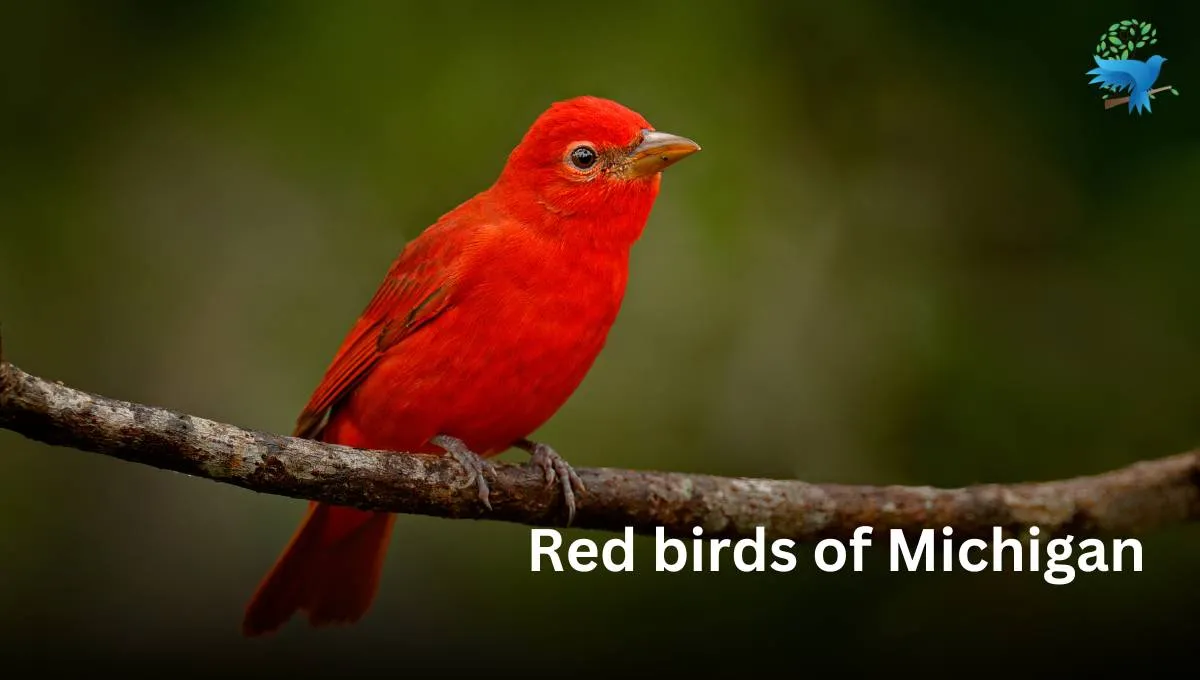
Michigan, often referred to as “The Great Lakes State” is a US state located in the Great Lakes region. It is the only state to be split into two large land segments: the Upper Pennisula and the Lower Pennisual.
Michigan diverse habitats, which include forests, wetlands, and urban areas, make it a home to a variety of beautiful bird species.
There are in fact 450 species of birds in Michigan. Among them, there are several species that are predominantly red. Some of these species live in Michigan all year long, others are migratory and only part-time residents of the state.
In this article, we talk about ten red birds of Michigan, including where they live, what they eat, and their color. So let’s take a look at each one!
List of red birds of Michigan:
- Red-necked grebe
- Northern cardinal
- White-winged crossbill
- Common redpoll
- Pine grosbeak
- Red-bellied woodpecker
- House Finch
- Hairy woodpecker
- Summer tanager
- Hepatic tanager
1. Red-necked grebe (Podiceps grisegena)
The red-necked grebe is a medium-large bird, that belongs to the genus Podiceps.
Also, it is the thickest waterbird, similar in size to many ducks, but with a longer neck and a heavy, pointed bill. Speaking about color pattern, nonbreeding birds are mainly dark gray above, and paler below, with pale cheeks and sides of the neck.
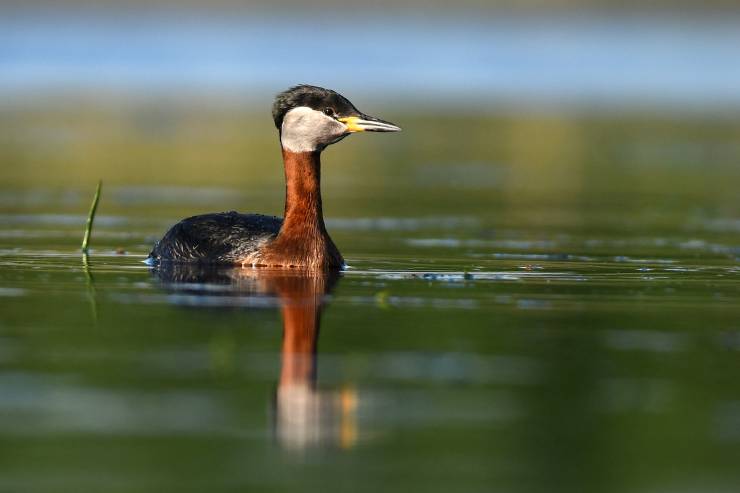
While breeding adults have a rusty red breast and foreneck, with a smart black cap and sharply defined white cheek.
Despite this, immatures are similar to nonbreeding adults, but the head pattern is less distinct.
Size and wingspan of Red-necked grebe:
- Size: 43-56 cm (16.9-22.1 inches)
- Weight: 800-1600g (28.2-56.4 oz)
- Wingspan: 61-88 cm (24.0-34.6 inches)
Habitat: It is found in the temperate regions of the northern hemisphere. During the breeding season, Red-necked grebes prefer freshwater habitats, particularly small lakes, marshes, and ponds.
They favor shallow, vegetated wetlands surrounded by forested land. These birds live in marshy ponds and lakes in summer.
Whereas in winter and during migration, their habitat is largely restricted to calm water just beyond the waves around ocean coasts, although some birds may winter on large lakes. Also, they can be found on large lakes, coastal bays, and estuaries.
Feeding: It is a versatile eater with a diet that varies by season. During the summer months in their breeding grounds, they primarily consume invertebrates, including water beetles and dragonfly larvae.
However, they are also known to eat small fish such as perch, sunfish, and minnows. In winter, their diet consists mainly of small fish.
The red-necked grebes also eat a variety of aquatic crustaceans like crayfish and small carbs as well, as mollusks. Sometimes, they consume tadpoles, nereid worms, and a small amount of plant matter.
2. Northern cardinal (Cardinalis cardinalis)
The northern cardinal is a mid-sized perching songbird. It is known informally as the redbird, common cardinal, red cardinal, or just cardinal.
Also, this species expresses sexual dimorphism. The northern cardinal male is brilliant red all over, with a reddish bill and black face immediately around the bill.
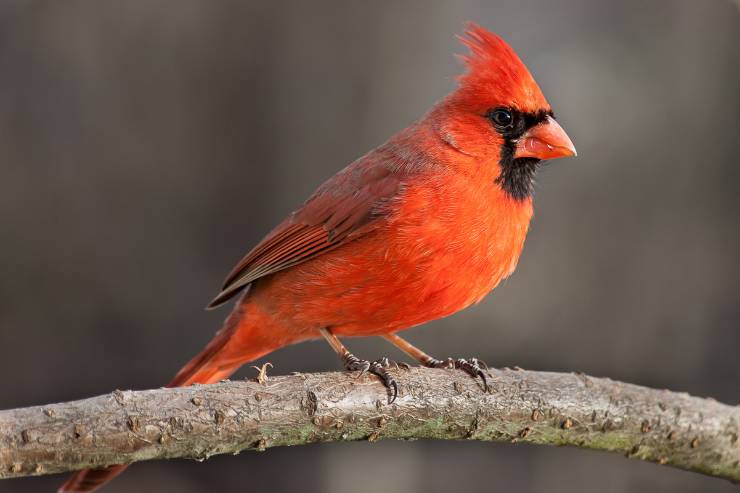
Whereas, females are pale brown overall with warm reddish tinges in the wings, tail, and crest. Both sexes have the same black face and red-orange bill.
They frequently sit with a hunched-over posture and with the tail pointed straight down.
Size and wingspan of Northern Cardinal:
- Size: 21-23 cm (8.3-9.1 inches)
- Weight: 42-48 g (1.5-1.7 oz)
- Wingspan: 25-31 cm (9.8-12.2 inches)
Habitat: These species are widespread across North America, from Canada to Mexico. Also, in Michigan, they remain year-round throughout the state.
The northern cardinal habitat includes woodlands, shrublands, gardens, and wetlands. These birds nest in dense tangles of shrubs and vines.
Feeding: They are mostly granivorous, but also feed on insects and fruits.
3. White-winged crossbill (Loxia leucoptera)
The white-winged crossbill commonly known as the two-barred crossbill, is a small passerine bird in the finch family Fringilidae.
They have stout bodies and distinct crossed bills, perfect for extracting seeds from conifer cones.

The white-winged crossbill males have beautiful red plumage on their heads and bodies, with black wings that feature two bold white stripes.
While female and immature birds are more olive-green or yellowish. Also, they have white strips on the wings, which is where the bird gets its name.
Size and wingspan of White-winged crossbill:
- Size: 15-17 cm (5.9-6.7 inches)
- Weight: 24-26g (0.8-0.9 oz)
- Wingspan: 26-28 cm (10.2-11.0 inches)
Habitat: This bird is primarily seen during the winter months in Michigan, but is more populous in the north of the state, where some remain year-round.
White-winged crossbills breed in the coniferous forest of Alaska, Canada, the northernmost United States, and across the Palearctic extending into northeast Europe.
Feeding: It mainly consists of spruce and tamarack seeds. During summer, it consumes insects, especially spruce budworms and coneworm, along with ants, spiders, and bugs.
4. Common redpoll (Acanthis flammea)
The common redpoll scientifically known as Acanthis flammea, is a species of bird in the Acanthis genus. It is also known as the mealy redpoll.
It is a brownish-grey bird with dark streaks and a bright red patch on its forehead. Also, it has a black bib and two pale stripes on the wings.
Common redpoll males often have their breasts suffused with red. The rump is streaked and there is a board dark brown streak across the vent.
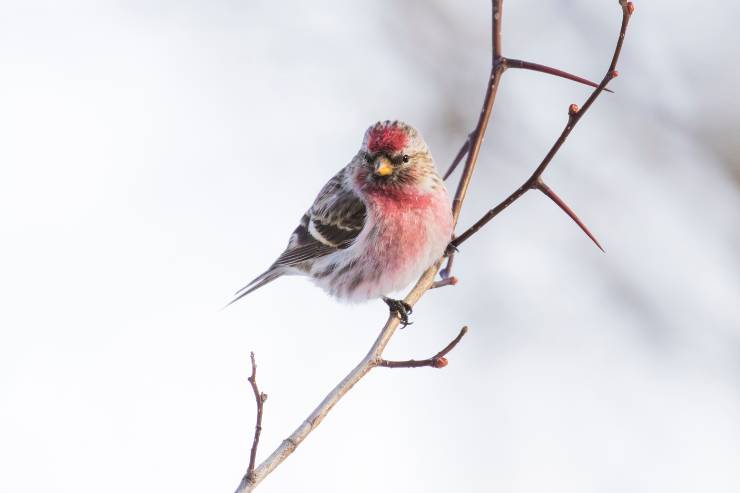
In addition, it has brown legs, dark-tipped yellowish bills, and dark brown irises.
Size and wingspan of Common Redpoll:
- Size: 12-14 cm (4.7-5.5 inches)
- Weight: 11-20g (0.4-0.7 oz)
- Wingspan: 19-22 cm (7.5-8.7 inches)
Habitat: They are found through northern Europe and Asia to northern North America, Greenland, and Iceland. Also, they can be seen in Michigan between October and May.
These birds prefer to live in boreal forests of pines, spruces, and larches. Moreover, they can be found in tundra, brushy and weedy fields, and around towns.
Feeding: The common redpolls feed mostly on seeds, principally birch and alder seeds, in winter.
They can also eat some wildflowers, grasses, sedges, and occasionally berries. In summer, they will supplement their diet with spiders and insects.
5. Pine grosbeak (Pinicola enucleator)
Pine grosbeak is one of the largest species in the true finch family. Also, it is the only species in the genus Pinicola.
They have a long forked black tail, black wings with white wing bars, and a large bill. Males have a rose-red head, back, and rump.
Also, they have black wings and tails, with a conical beak. The pine grosbeak females are olive-yellow on the head and rump and grey on the back and underparts.
On the other hand, young birds have less contrasting plumage overall, appearing shaggy when they molt their colored head plumage.
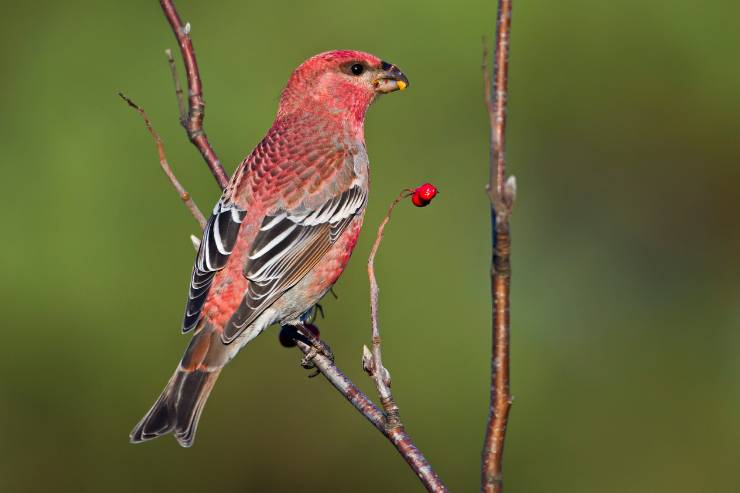
Size and wingspan of Pine grosbeak:
- Size: 20-25.5 cm (7.9-10.0 inches)
- Weight: 56.4 g (1.99 oz)
- Wingspan: 33 cm (13.0 inches)
Habitat: They are found across Alaska, the western mountains of the United States Canada, in subarctic Fennoscandia, and across the Paleartic to Sieria.
The pine crossbeaks can be spotted in Michigan during the winter months when they make their way down the northern regions of North America in search of food.
These birds have also been known to live in coniferous forests and other woodlands of the sort.
Feeding: Their diet mostly includes seeds, berries, buds, and fruits. During summer they may catch insects and spiders.
6. Red-bellied woodpecker (Melanerpes carolinus)
The red-bellied woodpecker is a sleek, round-headed woodpecker, about the same size as a Hairy woodpecker but without the blocky outlines.
Adult birds are mostly light gray on the face and underparts. Also, they have black and white barred patterns on their back, wings, and tail.
The red-bellied woodpecker males have a red cap going from the bill to the nape. While females have a red patch on the nape and another above the bill.
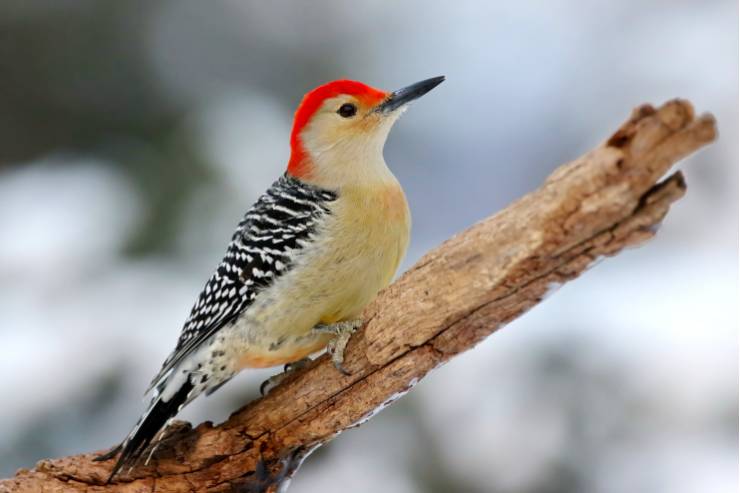
The reddish tinge on the belly that gives the bird its name is difficult to see in field identification.
Size and wingspan of Red-bellied woodpecker:
- Size: 24 cm (9.4 inches)
- Weight: 56-91 g(2.0-3.2 oz)
- Wingspan: 33-42 cm (13.0-16.5 inches)
Habitat: They are a common year-round resident throughout Michigan. These species breed mostly in the eastern United States, ranging as far south as Florida and as far north as Canada.
They usually inhabit deciduous forests near rivers and streams. It can also be found in plantations, groves, gardens, and urban areas.
They frequently announce their presence with rolling high-pitched “charr” or Kwirr” calls.
Feeding: They are omnivores and eat insects, fruits, nuts, and seeds.
7. House Finch (Haemorhous mexicanus)
The House finch is a moderate-sized songbird native to western North America. It has been introduced to the eastern half of the continent and Hawaii.
Males are rosy red around the face and upper breast, with streaky brown back, belly, and tail. During the flight, the red rump is noticeable.
Although the house finch females are not red. They are plain grayish-brown with thick, blurry streaks and an indistinctly marked face.

Size and wingspan of House finch:
- Size: 13-14 cm (5.1-5.5 inches)
- Weight: 16-27 g (0.6-0.9 oz)
- Wingspan: 20-25 cm (7.9-9.8 inches)
Habitat: These species are year-round residents in Michigan and can be found throughout the state.
The house finches breeding inhabit urban and suburban areas, as well as various semi-open areas in the west from southern Canada to the Mexican state of Oaxaca.
There are estimated to be anywhere from 267 million to 1.7 billion individuals across North America.
Feeding: It especially eats grains, seeds, and berries, being voracious consumers of weeds such as nettle and dandelion.
They may sometimes consume small insects such as aphids.
8. Hairy woodpecker (Leuconotopicus villosus)
The hairy woodpecker is a medium-sized woodpecker in the genus Leuconotopicus. It has a fairly square head, a long, straight, chisel-like bill, and stiff, long tail feather to lean against on tree trunks.
Likewise, adult Hairy woodpeckers are mostly black on the upper parts and wings, with a white or pale back and white sporting on the wings.
Also, there is a white bar above and one below the eye as well as a black tail with white outer feathers.
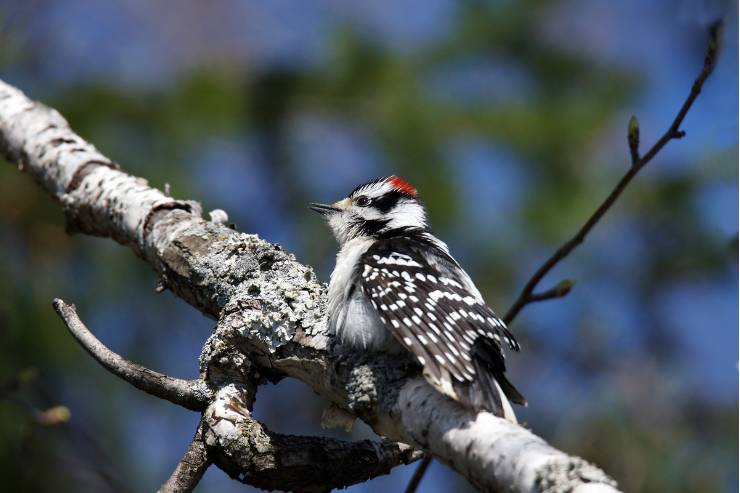
Adult males have a red patch or two side-by-side patches on the back of the head, while juvenile males have red or rarely orange-red on the crown.
Size and wingspan of Hairy woodpecker:
- Size: 18-26 cm (7.1-10.2 inches)
- Weight: 40-95 g (1.4-3.4 oz)
- Wingspan: 33-41 cm (13.0-16.1 inches)
Habitat: It is found over a large area of North America. Also, it is a year-round resident of Michigan.
The hairy woodpeckers inhabit mature deciduous, coniferous, and mixed forests, woodland, forest edges, and groves along rivers.
Feeding: These birds mostly eat insects, but also fruits, berries, and nuts, as well as tree sap and suet.
They are able to hear the movement of the insects under the tree bark due to the vibrations they make.
9. Summer Tanager (Piranga rubra)
The summer tanagers are medium-sized, chunky songbirds with big bodies and large heads. It belongs to the family Cardinalidae.
Regarding Summer tanagers color pattern, adult males are entirely bright red. Whereas, females and immature males are bright yellow-green-yellower on the head and underparts and slightly greener on the back and wings.
Its bill is pale. Also, molting immature males can be patchy yellow, and red. They are smaller than an American Robin and larger than a Yellow Warbler.
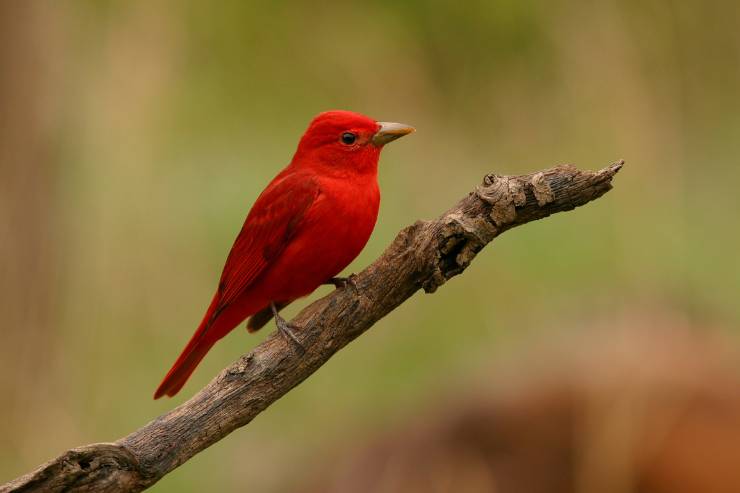
Size and wingspan of Summer Tanager:
- Size: 17 cm (6.7 inches)
- Weight: 29 g(1.0 oz)
- Wingspan: 28-30 cm
Habitat: The summer tanagers spend their winter in Central and South America but can sometimes be seen during the summer months in Michigan.
They breed across the southern US, extending as far north as lowa, and migrate to Mexico, Central America, and northern South America.
These species prefer open wooded areas, especially with oaks, and riparian areas. Also, they often occur along forest edges, in parks, and in gardens.
Feeding: It generally eats insects, especially wasps and bees. However, when insects are scares they will feed on fruit and berries.
10.Hepatic tanager ( Piranga flava)
The hepatic tanager scientifically known as Piranga flava, is a medium-sized American songbird.
Males are grayish brick-red above, reddish below, with a grayish ear patch. While females are olive-yellow above, and yellowish below, with a dusky ear patch.
Although, juveniles are grayish olive above, buffy below, and lightly streaked overall. Compared to females immature are duller. The bills and legs of all birds are dark.
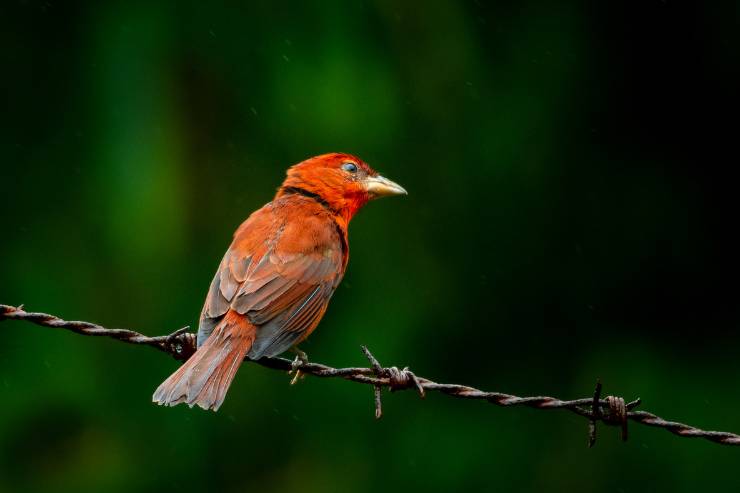
Size and wingspan of Hepatic tanager:
- Size: 8.8-20 cm (3.5-7.9 inches)
- Weight: 23-47 g (0.8-1.7 oz)
- Wingspan: 32 cm (12.6 inches)
Habitat: The hepatic tanager ranges from the southwestern United States to northern Argentina and Uruguay.
They are very rare red birds in Michigan and they have only been spotted twice in the last 10 years as accidental winter visitors.
They can also be found in mountain ranges with pine or pine and oak woodlands.
Feeding: They primarily consume insects and spiders. Occasionally, they also eat some berries such as cherries and grapes.
Conclusion
Michigan diverse habitats are home to a stunning array of red birds.
From the vibrant Northern Cardinal to the unique hairy woodpecker, each species adds a touch of color and charm to the landscape.
These birds, with distinctive appearances and behaviors, contribute significantly to the state-rich biodiversity. Whether you’re a seasoned birdwatcher or a casual nature enthusiast, the sight of these red birds in Michigan is sure to captivate and inspire.
So, the next time you’re in Michigan, do not forget to look up. You might just spot a flash of red among the green!






